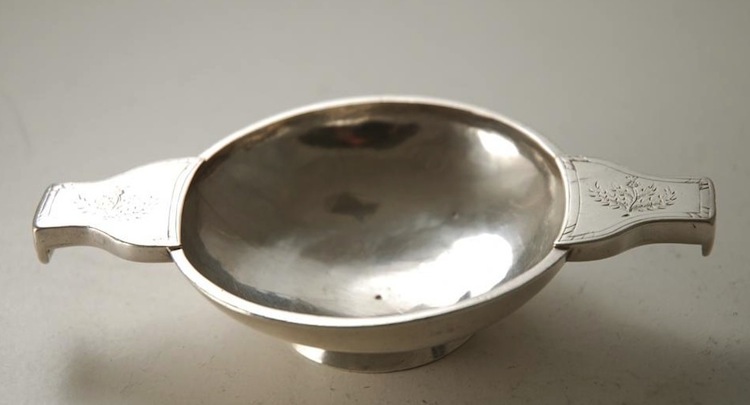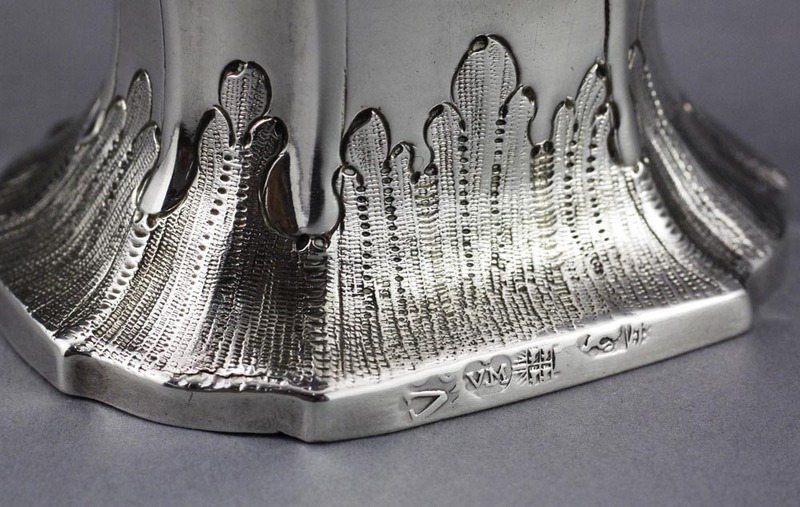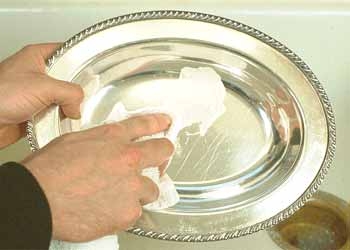LONDON, England (1300 – Present)
London Assay Office
Goldsmiths’ Hall
Gutter Lane
London EC2V 8AQ
Telephone 020 7606 8975
[email protected]
Throughout the nineteenth century (and still today), every British-made silver object offered for sale was required to bear four marks struck into the metal in a conspicuous place. One, the sterling mark, showed that the piece had been tested at the assay office and found to have met the standard of purity for sterling (92.75 percent pure silver alloyed with 7.25 percent strengthening copper). In London, Birmingham, and Sheffield, the three busiest assay-office towns, this mark was the “lion passant”—a lion in left profile walking to the left. Smaller centers used other sterling marks, such as a thistle in Edinburgh and a harp crowned in Dublin.
Along with the traditional hand-wrought objets d’art that had always been made as special commissions for elite clientele, production broadened to include ordinary dinner services, tea sets, and domestic implements such as light fixtures and writing tools.
The second required mark was a symbol identifying the town where the assay-office was located—for London, a lion’s head full face, in Birmingham an anchor, and in Sheffield a crown. A third mark was the date mark, a letter of the alphabet used for the twelve-month period during which the piece was assayed. The style and even the number of letters varied from office to office. London, for example, used only a-u, Chester used the entire alphabet, and both omitted j. Altogether there were twenty large and small assay offices in the nineteenth century, each with its own system of date letters. The date letter year in London, for example, ran from May 20 in one year to May 18 the following year, for the very good reason that the goldsmiths’ year began on May 19, the festival day of their patron saint Dunstan, when no business was transacted, and ended the following year on Saint Dunstan’s Eve, May 18.
The fourth mark was the maker’s mark, usually the initials of the first and last names of the maker or individual who owned and operated the workshop where the object was made. In addition, up to 1890, a fifth mark was required: the duty mark, consisting of the sovereign’s head in profile, struck to certify that the maker had paid the duty or tax at the time of assay. The tax was eliminated in 1890.
Hallmarks on British silver make it possible to identify the maker, and the place and date of manufacture, although their original purpose was to protect the silver coinage from conversion by goldsmiths and silversmiths to the raw material for their products. The hallmarking laws date back to 1300, when the first mark for the sterling standard test was established. The marks are an interesting study in themselves; on nineteenth-century works, they are generally evenly struck, legible, and have not become eroded from years of domestic use and polishing. Numerous books on British hallmarks exist, all taking as a point of departure Charles Jackson’s English Goldsmiths and Their Marks: A History of the Goldsmiths and Plate Workers of England, Scotland, and Ireland (which also includes Wales).
Another long-established regulation, the 1562 Apprenticeship Act of Elizabeth I, was repealed in 1814. This law had required all persons practicing a trade to have served a seven-year apprenticeship to a master in that trade, and to have passed a proficiency examination before he could be employed as a worker in the trade. The Apprenticeship Act naturally included boys who would be goldsmiths. (Even if most of their work was in silver, all workers in the precious-metal trades were called goldsmiths.) The repeal of the act greatly accelerated the Industrial Revolution.
In 1816, Britain adopted the gold standard. The gold sovereign thus became the highest unit of value, above the former sterling money. This change was accompanied by two further developments. First, the supply of silver dramatically increased with the discovery of large deposits of silver-bearing ores in North America and Australia and the renewal of activity and export of silver from long established mine operations in Mexico, South America, Germany, Spain, and Austria. Second, there was a significant expansion of the middle class in Europe, America, and Britain itself.
These changes transformed the work of silver- and goldsmiths. Along with the traditional hand-wrought objets d’art that had always been made as special commissions for elite clientele, production broadened to include ordinary dinner services, tea sets, and domestic implements such as light fixtures and writing tools. Geared to the middle-class market, these goods were increasingly produced by industrial methods in set patterns. There was also a very large output of comparatively modest small wares such as bouquet holders, spoons and other flatware, bells, pens, baby rattles, brush backs and other dressing table equipment, small picture frames, dolls’ tea sets, book markers, and literally hundreds more types of objects that were within the means of all but the very poor.
Even as the market broadened, silver remained conservative in design. Old styles were revisited, or deployed with small changes to make them look contemporary. Medieval, Renaissance, Baroque, Rococo, and Neoclassical motifs were common; especially popular was silver in the Queen Anne style. Manufacturers tended to order designs from one source and have them made up in their factories, although some employed artists to supply designs, introducing figural and animal sculptures and reliefs into their commercial offerings. Beginning in the 1870s, some factories established art studios to produce hand-wrought pieces in advanced designs. It was through this practice, along with the survival of small workshops, that hand processes were preserved and vanguard styles found expression in the medium of silver. These styles included, most notably, Arts and Crafts, japonisme, and Art Nouveau, all of which were ultimately absorbed into the production of industrialized makers.
The crowned leopard’s head was used 1478 – 1822, the uncrowned from 1822 – Present.


![]() TABLE OF LONDON DATE LETTERS • 1696 – 1935
TABLE OF LONDON DATE LETTERS • 1696 – 1935
City of London, 1789 by Turner & Williams

London Date Letters • 1696 – 1935
The shape of the shield cartouche around the City Mark and Standard Mark generally change to match the shield around the Date Letter Mark.

LONDON MAKERS’ MARKS
| A B S | Adey B Savory | PL | Pierre Plate |
| AF SG |
Andrew Foglebert & Stephen Gilbert |
PL | Paul de Lamerie (crown and star above, fleur-de-lys below) |
| AS | Thomas Ash | PS | Paul Storr |
| BC | Benjamin Cooper | Py | Benjamin Pyne (rose and crown above) |
| BS | Benjamin Smith | RC | Richard Crossley |
| BS BS |
Benjamin Smith & Son |
RC GS |
Richard Crossley & George Smith |
| Bu/BU | Thomas Burridge | R DH H |
Robert & David Hennell |
| CF | Charles Fox or Crispin Fuller |
RE EB |
Rebecca Emes & Edward Barnard |
| CK | Charles F Kandler (star below) |
RE WE |
Rebecca & William Emes |
| CO | Augustin Courtauld (fluer-de-lys above) |
RG | Robert Garrard |
| CR | Charles Rawlins | RH | Robert Hennell |
| CR DR |
Christian & David Reid | RH DH |
Robert & David Hennell |
| CR GS |
Charles Reilly & Geroge Storer |
RH DH SH |
Robert, David & Samuel Hennell |
| CR WS |
Charles Rawlins & William Summers |
RH SH |
Robert & Samuel Hennell |
| DH | David Hennell | RM RC |
Robert Makepeace & Richard Carter |
| DM | Dorothy Mills | RM TM |
Robert & Thomas Makepeace |
| DPW | Dobson, Prior & Williams |
Ro | Philip Rolles |
| DS BS |
Digby Scott & Benjamin Smith |
RR | Richard Rugg or Robert Rutland |
| DS RS |
Daniel Smith & Robert Sharp |
RS | Robert Swanson |
| EC | Ebenezer Coker | SA | Stephen Adams |
| EF | Edward Feline | Sc | William Scarlett |
| ET | Elizabeth Tuite | SC IG |
S & J Crespelt |
| EW | Edward Wigan | SG | Samuel Godbehere |
| EY | Edward York | SG EW |
Samuel Godbehere & Edward Wigan |
| FC | Francis Crump | SL | Gabriel Sleath |
| FO | Thomas Folkingham | SM | Samuel Merton |
| GA | George Adams | Sp | Thomas Spackman |
| GS | George Smith | S WI A |
Stephen Adams & William Jury |
| GS WF |
George Smith & Willaim Fearn |
TH | Thomas Heming |
| GW | George Wintle | TH IC |
Thomas Hannam & John Crouch |
| HA | Pierre Harache (crown above) |
T & W | Turner & Williams |
| HB | Hester Bateman | TN | Thomas Northcote |
| HC | Henry Chawner | TO | Thomas Oliphant |
| HC IE |
Henry Chawner & John Emes |
TP ER |
Thomas Phipps & Edward Robinson |
| HN | Hannah Northcote | TP ER JP |
Thomas Phipps, Edward Robinson & James Phipps |
| IB | James Bult | TP IP |
Thomas & James Phipps |
| IC | John Carter | TR | Thomas Robins |
| IG | John Gould | T WC C |
Thomas & William Chawner |
| IH | John Hyatt | WB | William Burwash |
| IL HL |
John & Henry Lias |
WC | William Cafe |
| IL HL CL |
John, Henry & Charles Lias |
WE | William Eaton or William Eley |
| IP | John Pollock | WE CE HE |
William, Charles & Henry Eley |
| IS | John Swift or John Scholfield |
WE GP |
William Eley & George Pierrepont |
| IW IT |
John Walcelon & John Taylor |
WE WF |
William Eley & William Fearn |
| JA | Joseph Angell | WF | William Fearn |
| JA JA |
J & J Aldous | WF PS |
William Frisbee & Paul Storr |
| JC | John Cafe | WG | William Grundy |
| JE | John Emes | WI | David Willaume |
| JL | John Lias | WP | William Peaston or William Plummer |
| LA | Paul De Lamerie (crown & star above) |
WRS | W R Smiley |
| LO | Nathaniel Lock | WS | William Sumner William Smiley |
| LP | Lewis Pantin | WT | William Tweedie |
| MC | Mary Chawner | W WP S |
William Shaw & William Priest |
| ME | Louis Mettayer | ||
| MS | Mary Sumner | ||
| Ne | Mary & Elizabeth Sumner |
||
| NS | Nicholas Sprimont | ||
| PB AB |
Peter & Anne Bateman |
||
| PB AB WB |
Peter, Anne & William Bateman |
||
| PB IB |
Peter & Jonathan Bateman |
Credit: http://www.metmuseum.org











